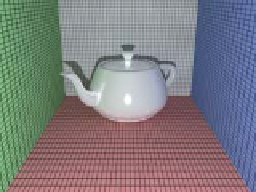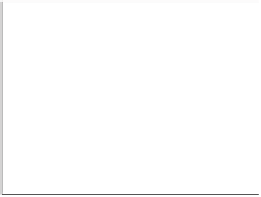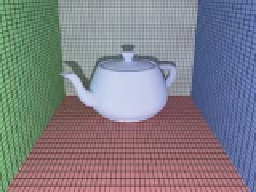Graphics Reference
In-Depth Information
light transmitted according to Snell's law. Once again, such impulse cases
require special handling in our programs.
•
Glossy
(Figure 27.5): The scattered light is concentrated around some par-
ticular direction
S
+
, which is typically at or near the mirror-reflection
direction. As noted earlier, the word “specular” is sometimes used to mean
“glossy,” typically when the concentration of scattered light is very tight.
The reflection from an enameled coffee mug has a substantial glossy com-
ponent: You can see things reflected in the mug's surface, although they
appear
slightly
blurred. A waxed linoleum floor has a somewhat glossy
appearance: You may be able to see objects reflected in it, but usually you
can only see the gross outlines, and all detail in the reflection has been
blurred away. The concentration of the scattered light is much less than
that scattered from the enameled mug. The Phong model of Chapter 6 is a
glossy-scattering model.
•
Diffuse:
The scattered light is spread out in all possible directions, that
is,
f
(
v
s
∈
Figure 27.5: Glossy scattering.
S
+
, or, more weakly,
f
(
v
o
)
is nonzero for all
v
o
∈
v
o
)
>
0
for a large fraction of all directions. Many of the materials we encounter in
everyday life exhibit diffuse scattering: paper, wood, brick, most cloth, etc.
v
i
,
v
i
,
•
Lambertian
(Figure 27.6): This is a special case of diffuse reflection in
which the outgoing radiance in direction
v
o
.Nomat-
ter what position you view it from, a diffuse surface looks equally bright.
This means that the BRDF, as a function of its second argument, is con-
stant:
f
r
(
v
o
is independent of
Figure 27.6: Lambertian scatter-
ing, the most diffuse possible.
S
+
.
v
o
)
for any two vectors
v
o
∈
v
i
,
v
o
)=
f
r
(
v
i
,
v
o
,
•
Retroreflective:
A surface is retroreflective if
f
s
(
v
i
,
v
o
)
is relatively large
for some vector
v
i
. Often the surface is specular, and the
specular peak direction is very near
v
o
that's close to
v
i
. Retroreflective paint is used on road
signs to make themmore visible to drivers (whose headlights illuminate the
signs), and retroreflective fabrics are often sewn into clothing for athletes
to make them particularly visible to cars at night.
•
Refractive:
This is a special case of transmission analogous to mirror
reflection: The transmitted light all lies in the direction
f
s
(
i
,
o
)
n
o
S
-
determined
i
v
t
∈
by Snell's law.
For each of the classes of scattering described above, we can translate the
description into a characterization of the BSDF, with some of the characterizations
more precise than others. Because the BSDF is a function of two arguments, the
direction
Figure 27.7: Plotting the BSDF.
The arriving light comes from
the left along direction
−
v
v
o
of the scattered light, it's
difficult to give a complete depiction. Instead, we pick a representative direction
v
i
, and we plot the BSDF as a function of
v
i
of the arriving light and the direction
i
;a
v
o
, that is, we draw a representation
v
typical outgoing direction
o
is
shown. The polar plot intersects
the radial direction of
of the function
v
o
→
f
s
(
v
i
,
v
o
)
. We further simplify by limiting ourselves to the
case where
v
o
are all in the same plane; with this restriction we can
draw a radial graph in the plane as shown in Figure 27.7.
The dependence of the BSDF-curve shape on
v
i
,
n
, and
v
o
at a dis-
tance f
s
(
v
i
,
v
o
)
.
v
i
tends to be relatively simple
in many cases, so this single plot can give a good sense of the overall function.
One important thing to understand is that the BSDF curve is
not
the pattern of
emitted radiation. You might imagine that if you sent a stream of photons toward
the material traveling in direction
−
v
i
, the resultant outgoing photons (e.g., in the
v
i
−
n
plane) would have an angular distribution given by the BSDF curve in that
plane (i.e., where the BSDF curve is twice as large, the probability density of a
photon emerging in that direction is twice as large). That's not correct, however, as


























